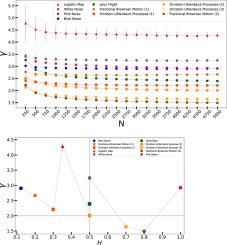持久性和非持久性时间序列的可见性图分析
IF 5.6
1区 数学
Q1 MATHEMATICS, INTERDISCIPLINARY APPLICATIONS
引用次数: 0
摘要
在这项工作中,我们研究了一系列时间序列,包括高斯噪声(白色,粉红色和蓝色),随机过程(Ornstein-Uhlenbeck,分数布朗运动和l本文章由计算机程序翻译,如有差异,请以英文原文为准。

Analysis of persistent and antipersistent time series with the Visibility Graph method
In this work, we investigate a range of time series, including Gaussian noises (white, pink, and blue), stochastic processes (Ornstein–Uhlenbeck, fractional Brownian motion, and Lévy flights), and chaotic systems (the logistic map), using the Visibility Graph (VG) method. We focus on the minimum number of data to use VG and on two key descriptors: the degree distribution , which often follows a power-law , and the Hurst exponent , which identifies persistent and antipersistent time series. While the VG method has attracted growing attention in recent years, its ability to consistently characterize time series from diverse dynamical systems remains unclear. Our analysis shows that the reliable application of the VG method requires a minimum of 1000 data points. Furthermore, we find that for time series with a Hurst exponent , the corresponding critical exponent satisfies . These results clarify the sensitivity of the VG method and provide practical guidelines for its application in the analysis of stochastic and chaotic time series.
求助全文
通过发布文献求助,成功后即可免费获取论文全文。
去求助
来源期刊

Chaos Solitons & Fractals
物理-数学跨学科应用
CiteScore
13.20
自引率
10.30%
发文量
1087
审稿时长
9 months
期刊介绍:
Chaos, Solitons & Fractals strives to establish itself as a premier journal in the interdisciplinary realm of Nonlinear Science, Non-equilibrium, and Complex Phenomena. It welcomes submissions covering a broad spectrum of topics within this field, including dynamics, non-equilibrium processes in physics, chemistry, and geophysics, complex matter and networks, mathematical models, computational biology, applications to quantum and mesoscopic phenomena, fluctuations and random processes, self-organization, and social phenomena.
 求助内容:
求助内容: 应助结果提醒方式:
应助结果提醒方式:


